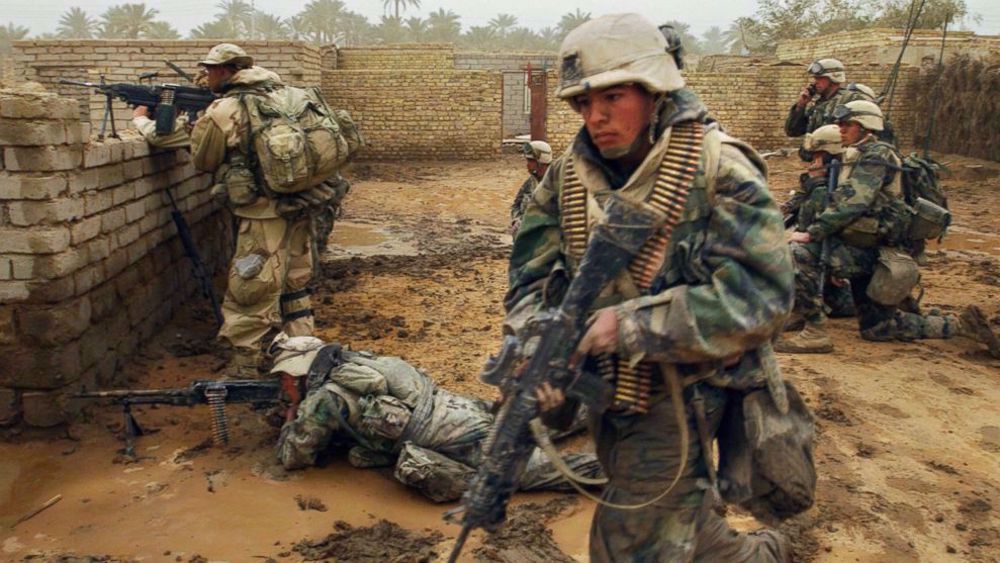
Washington did not find any evidence of weapons of mass destruction (WMD) in Iraq; however, it planted such munitions in the Arab country by bringing incompetent and corrupt officials to power, according to a former nuclear scientist and a former lieutenant in the Iraqi army.
Nearly twenty years after the United States invaded Iraq on March 20, 2003 and left a trail of destruction, death and chaos in the Arab country and the Middle East region based on Iraq’s supposed possession of actual WMDs, and the alleged threat they posed, military and scientific community say that there were no traces of WMD in Iraq.
“The US troops did not find Weapons of Mass Destruction; but were able to plant Weapons of Mass Destruction in the form of these parties and governors who governed Iraq for their own interests and destroyed it more than the occupier did,” former Iraqi lieutenant Jalil Khalaf Shuwail al-Muhammadawi said ahead of the 20th anniversary of the US-led military invasion.
Hamed al-Bahli, a nuclear scientist, also said that the UN weapons inspectors were sent in the year before the intervention but found almost nothing.
“The Head of International Inspection Teams declared that Iraq is free of Weapons of Mass Destruction,” he said at the former al-Tuwaitha Nuclear Research Center, located 18 kilometers (over 11 miles) southeast of Baghdad.
He added “They had destroyed all facilities … which were earmarked in the 1980s and 1990s for this purpose. Accordingly, he submitted a document stating that Iraq was free of Weapons of Mass Destruction.”
Nevertheless, the Bush administration invaded Iraq, and attacked the country with airstrikes and ground troops, with a devastating impact.
In 2005, US-organized elections were held in Iraq, and Western media outlets asserted that many welcomed them after more than two decades of deposed dictator Saddam Hussein’s rule.
Muhammadawi stated that they were the US’s own version of ‘WMDs’. Even though there is no suggestion that the US explicitly tried to influence the results at the time, contemporary reports point to a large rise in sectarian violence among the disparate groups in the following years, due to a lack of leadership and deep-seated corruption.
“This ancient country was destroyed by US and Western machinery and was returned to the Middle Ages, as former Secretary of State James Baker told the then Iraqi foreign minister Tariq Aziz, ‘we will bring you back to the Middle Ages if you proceed with your intransigence,’” Muhammadawi said.
“Everything was devastated. Cities, bridges, factories, electric power, and Baghdad and all cities were plundered, … all the state reserves were looted. Iraq turned into a bare, destitute, destroyed powerless country,” he regretted.
Resentment only intensified with media reports of US troops abusing Iraqi detainees at Abu Ghraib prison west of Baghdad. The torture methods sanctioned included sleep deprivation, hooding prisoners, playing loud music, removing all detainees’ clothing, forcing them to stand in so-called “stress positions”, and the use of dogs.
“The scandal that unfolded in the US-controlled Abu Ghraib prison was resounding, shameful. They treated Iraqi prisoners in a way that disgraced American and European civilization while defending freedom and humane treatment,” Muhammadawi said.
Bahli also argued that US forces may have found none in terms of actual WMDs, but their own weaponry had its own lasting impact.
“There were internationally prohibited weapons, containing depleted uranium. … As a result, many people have developed various diseases such as cancer, miscarriages, and birth defects. The intensity of the shelling was on Basra, Baghdad, and other areas causing enormously significant effects,” he said.
American forces admit to using hundreds of tons of depleted uranium weapons in Iraq, and the health impacts of the use of the weaponry in the country are yet to be known. Scientific reports have found anecdotal rises in birth defects and cancer rates.





Leave a Reply